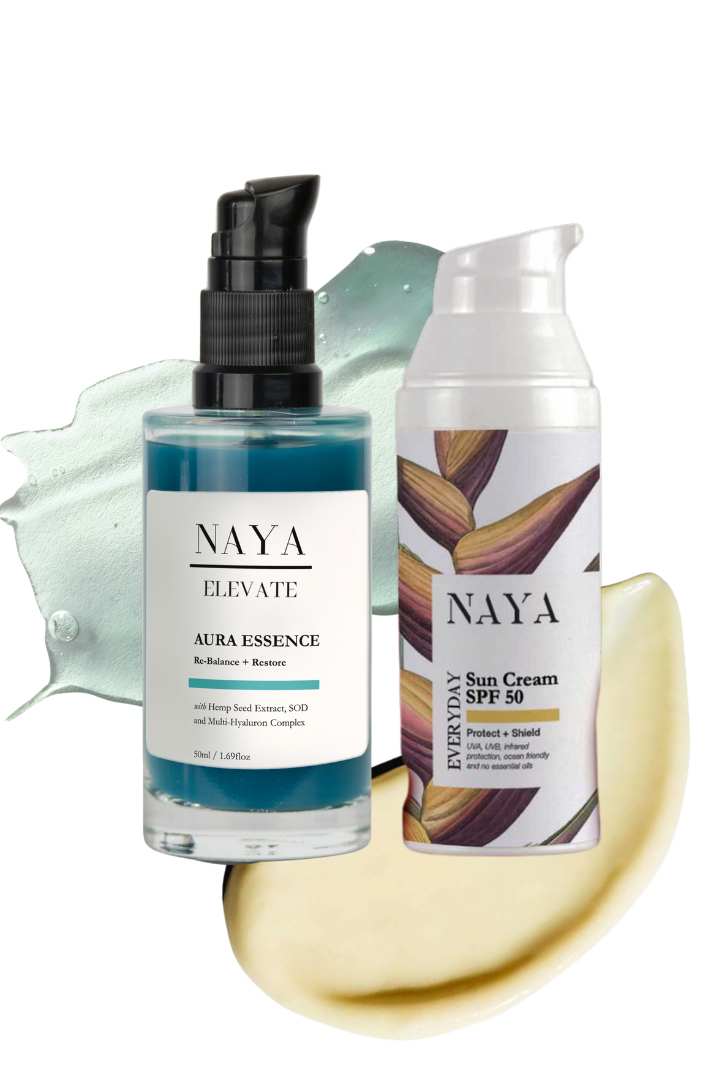Vitamin C: The Antioxidant Powerhouse
Is Vitamin C in skincare over-hyped?
Vitamin C serums is probably one of the most popular products with countless new launches every year. Their lasting popularity make a lot of sense! Simply put, Vitamin C (specifically l’ascorbic acid) is one of the most validated actives in the skincare world for its clinical benefits. It has been proven to prevent free radical damage, brighten hyperpigmentation, and even boost collagen production.
But given vitamin C’s popularity, it’s only gotten MORE difficult to choose the best vitamin C serum for your skin with the constant sea of new launches every season.
So let’s take a closer look at all the clinically tested skin benefits of vitamin C, why a good vitamin C formula is hard to come by, who should or shouldn’t use vitamin C, and when to incorporate this multifunctional powerhouse into your routine.
Ascorbic acid vs. other vitamin C derivatives
To start, one of the most important things for us to get out of the way is that not all vitamin C’s are created equal. In fact, vitamin C is actually a whole category of ingredients. However, almost all of the proven benefits of topical vitamin C you hear of actually comes from clinical studies done on specifically L-ascorbic acid (L-AA). This is why we’d consider ascorbic acid to be the true gold standard of the vitamin C serum landscape. We’ll focus the rest of this post on all things ascorbic acid, but if you’re curious about other forms of vitamin C, make sure to subscribe to my Youtube Channel.
Topical Vitamin C: a proven antioxidant
First and foremost, ascorbic acid is a proven, topical antioxidant. Skin is exposed to the daily damages of the day. External aggressors such as UVA, UVB, and pollution can create excess free radicals in skin. Free radicals are hyper reactive molecules that go on a rampage attacking anything in sight. Because of its unpaired electron, it desperately wants to pair up, making them highly reactive and creating oxidative stress. This leads to the disruption of your cells, mitochondria, and even your DNA. The accumulation of this daily damage leads to premature photoaging and comes in the forms of dull uneven skin tone, dark spots, wrinkles, and sagging skin.
Meet the antioxidants like ascorbic acid to save the day! Antioxidants work by “quenching” the free radicals, essentially sacrificing itself to spare your precious skin cells. This is why continued, consistent inclusion of vitamin C serums in your routine is one of the key steps to your long-term age-prevention strategy as well as other antioxidant-rich skincare products.
The Queen of Vitamin C: L-Ascorbic Acid
Let’s talk about the Queen of Vitamin C ingredients, the one and only active form: L-Ascorbic Acid. When people mention Vitamin C in skincare, they often aren’t referring to this specific form, so it’s important to clarify which type is being used. With so many derivatives available, it’s easy to get confused!
L-Ascorbic Acid is the purest and most researched form of Vitamin C. In fact, much of this research was pioneered by Sheldon Pinnell, the founder of SkinCeuticals. His work really set the foundation for how we understand Vitamin C in skincare today, which is why the SkinCeuticals C E Ferulic serum is still seen as the gold standard for over-the-counter Vitamin C products.
Key Findings from the Research:
So, what did Pinnell’s research reveal? There are a few key takeaways:
- Stability and Absorption: L-Ascorbic Acid is notoriously unstable and struggles to penetrate the skin. Pinnell found that lowering the pH to below 3.5 increased its absorption. So, if you’re buying a Vitamin C serum, check the pH level—it needs to be lower than 3.5 for effective absorption.
- The Power of Antioxidants: He also discovered that combining L-Ascorbic Acid with other antioxidants, like Vitamin E and Ferulic Acid, makes it much more stable and effective. This combo not only boosts its antioxidant power but also helps replenish Vitamin E on the skin.
When you put all of this together, studies showed that L-Ascorbic Acid helps with collagen production, reduces wrinkles, provides strong antioxidant protection, and evens out skin tone by targeting pigmentary changes.
So, Why Do We Still Use These Studies?
Now, here’s an interesting point. Steven, a content creator on Instagram, wrote a thoughtful article that questions the reliability of Pinnell’s research. It dives into some of the nuances and gaps, and I’ll link that below for you to check out. While there’s definitely room for debate, the truth is that we don’t have a ton of newer, more reliable research on L-Ascorbic Acid. So, even though there are questions about the old studies, they’re still the best we have—and that’s why most of us in the skincare community still rely on them today.
But aren’t there a lot of other good antioxidants out there?
Yes, there are.
But being an effective antioxidant isn’t ascorbic acid’s only skin benefit! Uneven pigmentation of any type (melasma, post-inflammatory hyperpigmentation, age spots, post acne marks, etc) can be one of the most persistent, frustrating skin concerns to deal with. Even so, ascorbic acid has been clinically tested to effectively brighten skin at as low as 5% in a skin serum. In fact, there was a small study done on a group of 16 patients with melasma for 16 weeks. The participants used 5% ascorbic acid serum on one side, and a 4% hydroquinone cream on the other side of the face. By the end of the study, both sides showed improvement. Even though the hydroquinone-treated side showed significantly more improvement, it also comes with a lot more irritation.
In a separate study, a much higher concentration 25% ascorbic acid serum was evaluated on 40 participants with melasma for twice-daily usage over 16 weeks. All participants showed significant improvement by the end of the study.
Last! But definitely not least, ascorbic acid has also been proven to boost collagen production.
Scientists have known since the 80s through in vitro testing on skin cells that the presence of ascorbic acid seems to boost collagen production. So in many clinical studies, study participants see active improvements in fine lines and wrinkles in addition to the skin brightening benefits.
In a French study done in the early 2000s, 20 participants applied a 5% vitamin C cream compared to a placebo over 6 months (an impressively long study in the skincare realm!). By the end of the study, the vitamin C treated side of the face had significantly less fine lines, wrinkles, and skin tissue was more dense. Skin biopsies also revealed that skin collagen appeared to be more “structured” in the vitamin C treated side. Very niceee…
Finding the Sweet Spot: Concentration
When it comes to L-Ascorbic Acid, concentration matters. You’re looking for that sweet spot—but technically anything from 5% to 15% can be effective. Any less, and you’re probably not getting much out of it. Any more, and you won’t see added benefits. Think of it like taking a Vitamin C supplement—your body can only absorb so much, and anything extra is just flushed out. So, more isn’t always better!
How do I choose the best vitamin C serum for my skin?
Convinced? Ready to add ascorbic acid to your skincare routine for the long haul? Like all powerhouse actives, there's always a catch. Ascorbic acid is infamously unstable in water, and can be a pain in the butt to formulate with. Trust us, we know. To get the most out of your vitamin C serum, you must choose one that’s formulated correctly so that the formula remains stable long enough for you to get all the benefits out of it. There are 3 main forms of vitamin C products you can choose from: classic water-based serum, anhydrous suspension, and powder vitamin C. Each of these have their own sets of pros and cons.
But as we said earlier, **Vitamin C is much more stable when used with a powerful antioxidant partner**. This means you should be on the lookout for a formula that combines Vitamin E and Ferulic acid with ascorbic acid.
How do I choose the best vitamin C serum for my skin?
Convinced? Ready to add ascorbic acid to your skincare routine for the long haul? Like all powerhouse actives, there's always a catch. Ascorbic acid is infamously unstable in water, and can be a pain in the butt to formulate with. Trust us, we know. To get the most out of your vitamin C serum, you must choose one that’s formulated correctly so that the formula remains stable long enough for you to get all the benefits out of it. There are 3 main forms of vitamin C products you can choose from: classic water-based serum, anhydrous suspension, and powder vitamin C. Each of these have their own sets of pros and cons.
Water-based vitamin C serums
This is THE classic vitamin C formula that has been patented and popularized by Skinceutical’s CE Ferulic. This format should be at a pH of lower than 3.5 with supporting antioxidants like vitamin E and ferulic acid to ensure vitamin C stability. That said, you’ll still slowly get that waft of hot dog and watch your formula gradually turn amber with this form. Since CE Ferulic’s patent expired, there’s a slew of dupes to choose from on the market.
Anhydrous vitamin C suspension serums
Water is THE main culprit behind vitamin C degradation. One way to prevent this degradation is to simply formulate it into anhydrous (waterless) formulas. We highly recommend patch testing this type of vitamin C. The high solvent load can be irritating to some skin types and some formulas may be too gritty to apply or work well on skin.
Vitamin C powders
This is THE most stable way to get your vitamin C. But sadly, the dosing can get pretty confusing and that’s why we provide a little spoon to our Antioxidant Defence Booster. So you can dose it accurately but also no mess in your bathroom.
Debunking the Iodine Test
Now, you might have seen those viral ‘iodine tests’ online, where someone puts iodine in a cup, adds some Vitamin C, and then it magically turns clear. They claim it shows how effective that product is—spoiler alert: it doesn’t. This test has nothing to do with how well a Vitamin C product works on your skin. It’s just a redox reaction happening because L-Ascorbic Acid is an active form of Vitamin C. So, if a derivative, like Sodium Ascorbyl Phosphate or THD Ascorbate, doesn’t react, it’s simply because those derivatives need to be converted into pure Vitamin C within the skin to be effective. The iodine test is irrelevant!
When Should You Use Vitamin C?
Ah, the great debate—should you use Vitamin C in the morning or at night? Or both?! Let's break it down.
So, the good news is, you can use it whenever you prefer—morning or night—but there are slight differences depending on the time of day.
Morning Application
If you use Vitamin C in the morning, its primary role is that of an antioxidant. Studies show that pairing it with your sunscreen can give you extra protection from UV rays and environmental aggressors like pollution. Basically, Vitamin C acts like your skin's personal bodyguard throughout the day.
Night Application
Now, if you use it at night, it’s not being broken down by sun exposure or pollutants, so its other benefits—like boosting collagen, improving skin tone, and reducing wrinkles—get maximized. But, here’s my take: I personally prefer to use other actives, like retinol, at night since those tend to give me better results. So, I typically reserve Vitamin C for my morning routine. And that way you can combine your Vitamin C and Retinol in one effective way.
Is Vitamin C Worth the Hype?
Okay, so, is Vitamin C worth all the buzz? Honestly... it depends. While the benefits of L-Ascorbic Acid are undeniable—antioxidant power, wrinkle reduction, and improved texture—it can be irritating, especially if you have sensitive skin like me. That’s because for it to really penetrate the skin, the pH needs to be pretty low, which can cause irritation for some people.
But don’t worry if your skin doesn’t love L-Ascorbic Acid! Skincare has evolved, and we have amazing alternatives that deliver similar, if not better, results without the irritation. So, if Vitamin C isn’t working for you, don’t feel like you’re missing out. There are other ingredients that may be even more exciting for your skin.
Key FAQ from our customers
Where does a vitamin C serum go in my skincare routine?
We suggest using vitamin C serum in your morning routine as one of your first steps. Generally speaking, vitamin C should be used before your moisturizer and sunscreen.
Should I use vitamin C in the AM and PM?
You can but it’s not necessary. In research, ascorbic acid was used once a day for its antioxidant properties. For tackling stubborn pigmentation concerns, the serum was used twice a day. It’s really up to you and what fits your routine best. There are other goodies I enjoy using during the evening, hence I prefer to use a Vit C serum during the day.
Can you use a vitamin C serum at any age?
Yes! Whether you’re interested in age prevention or tackling skin concerns, vitamin C is great for even teenage to mature skin.
I have sensitive skin, can I use vitamin C?
Consider starting with a lower concentration, water-based 5% ascorbic acid serum to start. Also, patch testing saves lives! If this still doesn’t work then you might need to go down the derivate routes. Key here is that you know your skin focus and what you actually want to achieve as skincare is complex and there are a number of ingredients out there that can achieve the same skin focus without irritating your skin.
Are there any side effects to vitamin C?
Everyone’s skin is unique, and ascorbic acid serums might not be for everyone. If your skin doesn’t agree with vitamin C, it might get red, irritated, or even break out. If that is the case, checkout vitamin C derivatives or non-vitamin C antioxidant options.
Takeaway
Vitamin C serums are great for actively tackling hyperpigmentation AND long term age prevention. It’s important to make sure you’re looking for serums with specifically, ascorbic acid, to reap all of the great Vitamin C benefits. Because Vitamin C is not stable in water, it typically comes in three types of products: water-based, anhydrous, and powders.
Does ascorbic acid not quite work for your skin? Curious about vitamin C derivatives or other antioxidants? Subscribe to my YouTube channel.
References
Pinnell, S. R., Yang, H., Omar, M., Riviere, N. M., Debuys, H. V., Walker, L. C., ... & Levine, M. (2001). Topical L‐ascorbic acid: percutaneous absorption studies. Dermatologic surgery, 27(2), 137-142.
Espinal‐Perez, L. E., Moncada, B., & Castanedo‐Cazares, J. P. (2004). A double‐blind randomized trial of 5% ascorbic acid vs. 4% hydroquinone in melasma. International journal of dermatology, 43(8), 604-607.
Hwang, S. W., Oh, D. J., Lee, D., Kim, J. W., & Park, S. W. (2009). Clinical efficacy of 25% L-ascorbic acid (C'ensil) in the treatment of melasma. Journal of cutaneous medicine and surgery, 13(3), 155-160.
References
Pinnell, S. R., Yang, H., Omar, M., Riviere, N. M., Debuys, H. V., Walker, L. C., ... & Levine, M. (2001). Topical L‐ascorbic acid: percutaneous absorption studies. Dermatologic surgery, 27(2), 137-142.
Espinal‐Perez, L. E., Moncada, B., & Castanedo‐Cazares, J. P. (2004). A double‐blind randomized trial of 5% ascorbic acid vs. 4% hydroquinone in melasma. International journal of dermatology, 43(8), 604-607.
Hwang, S. W., Oh, D. J., Lee, D., Kim, J. W., & Park, S. W. (2009). Clinical efficacy of 25% L-ascorbic acid (C'ensil) in the treatment of melasma. Journal of cutaneous medicine and surgery, 13(2), 74-81.
Murad, S., Grove, D., Lindberg, K. A., Reynolds, G., Sivarajah, A., & Pinnell, S. (1981). Regulation of collagen synthesis by ascorbic acid. Proceedings of the National Academy of Sciences, 78(5), 2879-2882.
Humbert, P. G., Haftek, M., Creidi, P., Lapière, C., Nusgens, B., Richard, A., ... & Zahouani, H. (2003). Topical ascorbic acid on photoaged skin. Clinical, topographical and ultrastructural evaluation: double‐blind study vs. placebo. Experimental dermatology, 12(3), 237-244.











Leave a comment